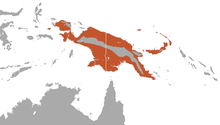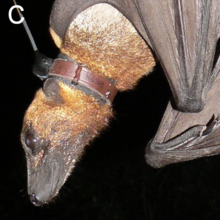Great flying fox
The great flying fox (Pteropus neohibernicus), also known as the greater flying fox or Bismarck flying fox, is a species of megabat in the genus Pteropus, found throughout lowland areas of New Guinea and in the Bismarck Archipelago. Conflicting evidence suggests that its closest relative is either the spectacled flying fox or, jointly, the Pelew and insular flying foxes. Two subspecies are recognized. At up to 1.6 kg (3.5 lb) in weight, it is among the heaviest bats in the world and the largest bat in Melanesia. It is a gregarious animal which roosts with hundreds or thousands of individuals.[1] It may forage during the day or night in search of fruit, including figs or fruits from the family Sapotaceae. It is considered a least-concern species, though its numbers have been negatively impacted by what appeared to be a disease, as well as by hunting for bushmeat that occurs across its range.
| Great flying fox | |
|---|---|
 | |
| Great flying fox in flight | |
| Scientific classification | |
| Kingdom: | Animalia |
| Phylum: | Chordata |
| Class: | Mammalia |
| Order: | Chiroptera |
| Family: | Pteropodidae |
| Genus: | Pteropus |
| Species: | P. neohibernicus |
| Binomial name | |
| Pteropus neohibernicus Peters, 1876 | |
 | |
| Great flying fox range | |
| Synonyms | |
Taxonomy
The great flying fox was described in 1876 by German naturalist Wilhelm Peters.[1] He listed it as a variety of the black-bearded flying fox, Pteropus melanopogon var. neohibernicus.[2] The holotype had been collected on the island of New Ireland, which is part of Papua New Guinea, by Carl Hüsker.[2] Neohibernicus is Latin for "of New Ireland".[3] Two subspecies are recognized:[4]
- P. n. hilli Felten, 1961
- P. n. neohibernicus Peters, 1876
Within the genus Pteropus, the great flying fox appears most closely related to the spectacled flying fox (P. conspicillatus) based on nuclear DNA. However, on the basis of mitochondrial DNA, it is sister taxon to a clade containing the Pelew flying fox (P. pelewensis) and the insular flying fox (P. tonganus), while the spectacled flying fox is sister to a clade including the Yap flying fox (P. yapensis) and the Admiralty flying fox (P. admiralitatum). The disagreement of nuclear and mitochondrial evidence suggests that the six species may have a complicated evolutionary history. The six species are considered part of the griseus species group within Pteropus, which additionally includes the Ceram fruit bat (P. ocularis), black flying fox (P. alecto), gray flying fox (P. griseus), and the small flying fox (P. hypomelanus).[5]
nuclear DNA (left) and nuclear and mitochondrial DNA (right)
| ||||||||||||||||||||||||||||||||||||
|---|---|---|---|---|---|---|---|---|---|---|---|---|---|---|---|---|---|---|---|---|---|---|---|---|---|---|---|---|---|---|---|---|---|---|---|---|
| ||||||||||||||||||||||||||||||||||||
|---|---|---|---|---|---|---|---|---|---|---|---|---|---|---|---|---|---|---|---|---|---|---|---|---|---|---|---|---|---|---|---|---|---|---|---|---|
Description

The great flying fox is the largest bat on the island New Guinea,[6] as well as the whole of Melanesia.[7] Its forearm length ranges from 165–207 mm (6.5–8.1 in),[8] and individuals can weigh up to 1.6 kg (3.5 lb).[3] This makes it one of the heaviest known species of bat.[9] Males are typically larger than females. Males have a head and body length of 266–330 mm (10.5–13.0 in), while females are 234–280 mm (9.2–11.0 in) long. Forearm lengths are 190–207 mm (7.5–8.1 in) and 165–173 mm (6.5–6.8 in) for males and females, respectively. It lacks a tail,[3] and has a long, narrow snout relative to the black-bearded flying fox.[10]
The color of its fur is variable, though often golden brown,[10] with the fur of its back usually sparse or absent.[11] It has a mantle, or fur of contrasting color on the sides and back of its neck. The mantle is usually yellowish.[10]
Biology and ecology

The great flying fox is highly gregarious, or social, and forms colonies consisting of several thousand individuals. During the day, it roosts in treetops. At night, it leaves its roost to forage for fruit. Its diet may include fruits from the family Sapotaceae, as well as figs[12] and Ceiba pentandra fruits.[3] It sometimes forages during the day, and has been observed skimming the sea to pluck fruits that are floating on the surface.[13]
Females give birth to a single offspring at a time.[1] Near Fulleborn, Papua New Guinea, it is thought that females give birth in early December.[3]
It is known to be parasitized by nematodes of the genus Litomosa, with the species L. hepatica newly described from a great flying fox.[14]
Range and habitat
The great flying fox is endemic to the southwest Pacific islands of New Guinea, the Bismarck Archipelago, and the Raja Ampat Islands, which are part of Indonesia and Papua New Guinea. There is one record of it from the Australian Thursday Island.[1] Its range includes several very small islands such as Karkar Island and Sakar Island. It is unknown why the great flying fox does not occur on nearby larger islands, such as the Louisiade Archipelago and the D'Entrecasteaux Islands.[12]
It has been documented at a range of elevations from 0–1,400 m (0–4,593 ft) above sea level. It is found in forested and savanna habitats.[1]
Conservation

The great flying fox may be threatened by disease. In 1985, many dead and dying individuals were found beneath their roosts on the island of Manus. The mass mortality event continued for several weeks across the entirety of the island; afterward, no great flying foxes were seen for several years.[7] Along with many other Pteropus species, it is included in Appendix II of the Convention on International Trade in Endangered Species of Wild Fauna and Flora (CITES).[15]
It is considered a common and abundant species, and is listed as least-concern by the IUCN as of 2008. It is unknown if its numbers are increasing, decreasing, or stable.[1]
Relationship to humans
The great flying fox has been researched to determine its role in the ecology of Hendra virus, which is a zoonotic virus that can infect humans. On the north coast of Papua New Guinea, it has tested positive for antibodies against the virus, known as seropositivity.[13] In Papua New Guinea, it is hunted for bushmeat.[16] Localized hunting occurs over a large part of its range, with higher levels in East Sepik Province.[1]
References
- Salas, L.; Helgen, K. & Hamilton, S. (2008). "Pteropus neohibernicus". The IUCN Red List of Threatened Species. IUCN. 2008: e.T18742A8531092. doi:10.2305/IUCN.UK.2008.RLTS.T18742A8531092.en.
- Peters, W. (1876). "Mittheilung über die Pelzrobbe von den Inseln St. Paul und Amsterdam und über die von S.M.S. Gazelle mitgebrachten Flederthiere" [Information about the fur seal from the islands of St. Paul and Amsterdam and about bats of the S.M.S. Gazelle]. Monatsberichte der Königlichen Preussische Akademie des Wissenschaften zu Berlin (in German): 317–318.
- Flannery, T. (1995). Mammals of the South-West Pacific & Moluccan Islands. Cornell University Press. p. 271. ISBN 0801431506.
- Wilson, D.E.; Reeder, D.M., eds. (2005). Mammal Species of the World: A Taxonomic and Geographic Reference (3rd ed.). Johns Hopkins University Press. ISBN 978-0-8018-8221-0. OCLC 62265494.
- Tsang, Susan M.; Wiantoro, Sigit; Veluz, Maria Josefa; Sugita, Norimasa; Nguyen, Y‐Lan; Simmons, Nancy B.; Lohman, David J. (2020). "Dispersal out of Wallacea spurs diversification of Pteropus flying foxes, the world's largest bats (Mammalia: Chiroptera)". Journal of Biogeography. 47 (2): 527–537. doi:10.1111/jbi.13750.
- Flannery, Timothy (1990). Mammals of New Guinea - The Australian Museum. Robert Brown & Associates, Carina, Qld., Australia. pp. 32–33. ISBN 1862730296.
- "Small populations on islands have unique conservation problems". Bats Magazine. Vol. 7 no. 4. 1989.
- Flannery, T. (1995). Mammals of the South-West Pacific & Moluccan Islands. Cornell University Press. p. 184. ISBN 0801431506.
- Fleming, T. H.; Racey, P. A., eds. (2010). Island bats: evolution, ecology, and conservation. University of Chicago Press. p. 17. ISBN 9780226253312.
- Flannery, Tim (1995). Mammals of New Guinea. NCROL. pp. 376–377. ISBN 978-0801431494.
- Wilson, Don E.; Graham, Gary Lynn (1992). Pacific Island Flying Foxes: Proceedings of an International Conservation Conference. U.S. Department of the Interior, Fish and Wildlife Service. p. 108.
- Mickleburgh, S. P.; Hutson, A. M.; Racey, P. A. (1992). Old World fruit bats: An action plan for their conservation (PDF) (Report). Gland, Switzerland: IUCN. pp. 118–119.
- Breed, Andrew C.; Field, Hume E.; Smith, Craig S.; Edmonston, Joanne; Meers, Joanne (2010). "Bats Without Borders: Long-Distance Movements and Implications for Disease Risk Management". Ecohealth. 7 (2): 204–212. doi:10.1007/s10393-010-0332-z. PMC 7087570. PMID 20645122.
- Guerrero, R.; Bain, O. (2011). "Study of types of some species of "Filaria" (Nematoda) parasites of small mammals described by von Linstow and Molin". Parasite. 18 (2): 151–161. doi:10.1051/parasite/2011182151. PMC 3671412. PMID 21678791.
- Appendices I, II and III (PDF) (Report). Convention on International Trade in Endangered Species of Wild Fauna and Flora. 26 November 2019. p. 16.
- Mildenstein, Tammy; Tanshi, Iroro; Racey, Paul A. (2016). "Exploitation of Bats for Bushmeat and Medicine". Bats in the Anthropocene: Conservation of Bats in a Changing World. pp. 325–375. doi:10.1007/978-3-319-25220-9_12. ISBN 978-3-319-25218-6. S2CID 130038936.
